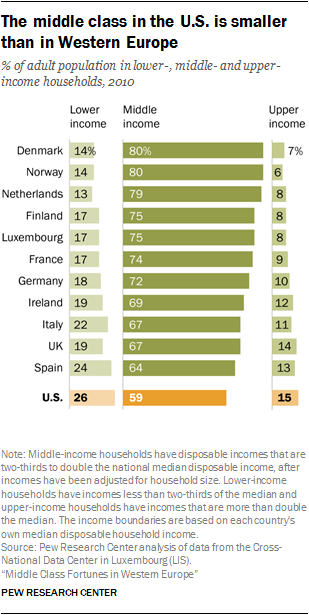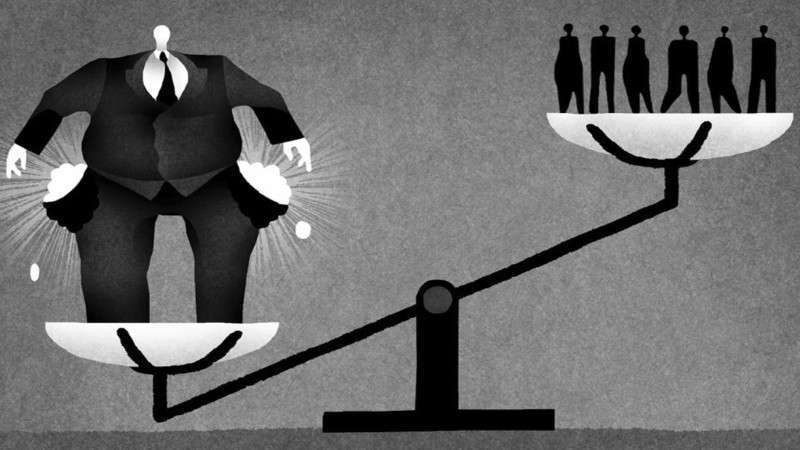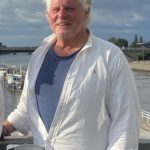If you ask me to describe my ideal place to live, I’d say, “A stable, safe country with a huge middle class and opportunities for all people to live comfortable and fulfilling lives.”
 Pretty basic … which apparently makes me a Western European; in my particular case, Dutch. At least according to the latest findings from the Pew Research Center, the nonpartisan Washington, D.C.-based think tank.
Pretty basic … which apparently makes me a Western European; in my particular case, Dutch. At least according to the latest findings from the Pew Research Center, the nonpartisan Washington, D.C.-based think tank.
My vision is most unAmerican because the United States is the only country in the Pew survey – which includes the U.S., Denmark, Norway, Netherlands, Finland, Luxembourg, France, Germany, Ireland, Italy, Spain and the United Kingdom – where fewer than six-in-ten adults were in the middle class.
In the recently published “Middle Class Fortunes in Western Europe,” Pew researchers, working with data from the Cross-National Data Center in Luxembourg, found the middle classes across the Nordics and Western Europe shrank from 1991 to 2010. But there’s a caveat: It’s likely income levels in 2010 were below what they might have been had the Great Recession not happened, states “Middle Class Fortunes.”
Woulda, shoulda, coulda.
The recession did happen, and it really left a dent in Spain and Italy. Nonetheless, from 1991 to 2010, the shares of adults living in middle-income households increased in France, the Netherlands and the United Kingdom.
The middle classes in Germany, Italy and Spain shrank during the same period.
The most middle class nations in Europe are Denmark and Norway, with 80 percent of their residents classified as “middle income,” according to Pew. That compares to only 59 percent of Americans, which does have twice the percentage of upper income at 15 percent, compared to 7 and 6 percent in Denmark and Norway respectively. The U.S. also has the highest percentage of adults in the lower income tier.
The Netherlands has the smallest percentage falling into the “lower income” category at 13 percent, half of the U.S., where 26 percent of Americans are classified as lower income.
Surprisingly, the winner – and there’s always a winner during times of economic upheaval – is the Republic of Ireland, according to Pew. The Celtic Tiger experienced the most rapid growth in income from 1991 to 2010 and the biggest expansion of the middle class.
Household income in Ireland rose to about $93,500 from $56,725 over that same period, or a 61-percent increase.
But winners and losers in Europe aside, the Pew research tells you more about the United States than Europe.
From the post:
The U.S. represents a significant exception to this general relationship between national income and the middle-income share. The median income in the U.S. – $53,000 – exceeded the median income in all countries but Luxembourg in 2010. As noted, however, the share middle class in the U.S. (59%) is less than in any of the selected countries from Western Europe.
Think about that for a minute, and you start to see how the U.S. is experiencing deepening income inequality … a polarization hollowing out the middle class, dividing households between the One Percent on one side, and the poorest 20 percent of residents on the other.
 Of course, there are lots of ways to parse economic data, and Pew does just that.
Of course, there are lots of ways to parse economic data, and Pew does just that.
Did more people in the U.S. move up the economic level, or down? What about Europe? And does the concept of “middle class” even translate between the two continents?
The answer to the last question is, “not really.” The American middle class has more disposable income than counterparts in Western Europe, with the exception of Luxembourg.
Middle-income households in Luxembourg earned a medium income of $71,799 annually in 2010, followed by $60,884 in the U.S. Middle class in Italy equals a median income of $35,608, the most modest means among the 12 countries, according to Pew.
Finally, what do the trend lines tell us?
The rich are getting richer everywhere. Except Ireland.
Ireland was the only country out of the 12 in the survey where the middle-class population percentage grew from 1991 to 2010 – to 66 percent from 60 percent. Finland had the most precipitous drop in the middle class – to 74 percent from 85 percent.
 The good news is, those upwardly mobile Finns apparently popped into the upper-income tier, which increased to 18 percent from 8 percent. The lower income tier increased by only 1 percentage point to 8 percent.
The good news is, those upwardly mobile Finns apparently popped into the upper-income tier, which increased to 18 percent from 8 percent. The lower income tier increased by only 1 percentage point to 8 percent.
The bottom line for me is, the dimming future of the middle class in the U.S. might be a harbinger of what’s to come in Europe as the Digital Age accelerates wage inequality. Because the bottom line is, there are workers who will have nothing but their labor to sell, and there are the highly skilled. And the complexity of moving from the former to the latter increases every day.
Because for every newly minted social media billionaire or ultra-high-tech entrepreneur, there are 100 people at the auto plant or appliance factory who don’t have the skills to shift to a global digital/tech economy.
The gritty details:
In this report, “middle-class” adults live in households with disposable incomes ranging from two-thirds to double the national median disposable household income.4 Disposable income includes earnings from work, interest and dividend income, rental income, and transfer income such as government assistance and family transfers, but subtracts income taxes and social security contributions. It is the only measure of income comparable across all countries in the source data.5
Estimates of income in this report are adjusted for household size and expressed in 2011 prices and purchasing power parities.6 This allows for comparisons across households of different sizes while adjusting for cost-of-living differences over time and across countries. Also, incomes are scaled to reflect a household size of three for reporting purposes.7 The average size of a household in the U.S. is 2.5 and is between two and three in the countries in Western Europe. (See the text box “Who is middle income?” and Methodology for details.)
Co-CEO of Dispatches Europe. A former military reporter, I'm a serial expat who has lived in France, Turkey, Germany and the Netherlands.















